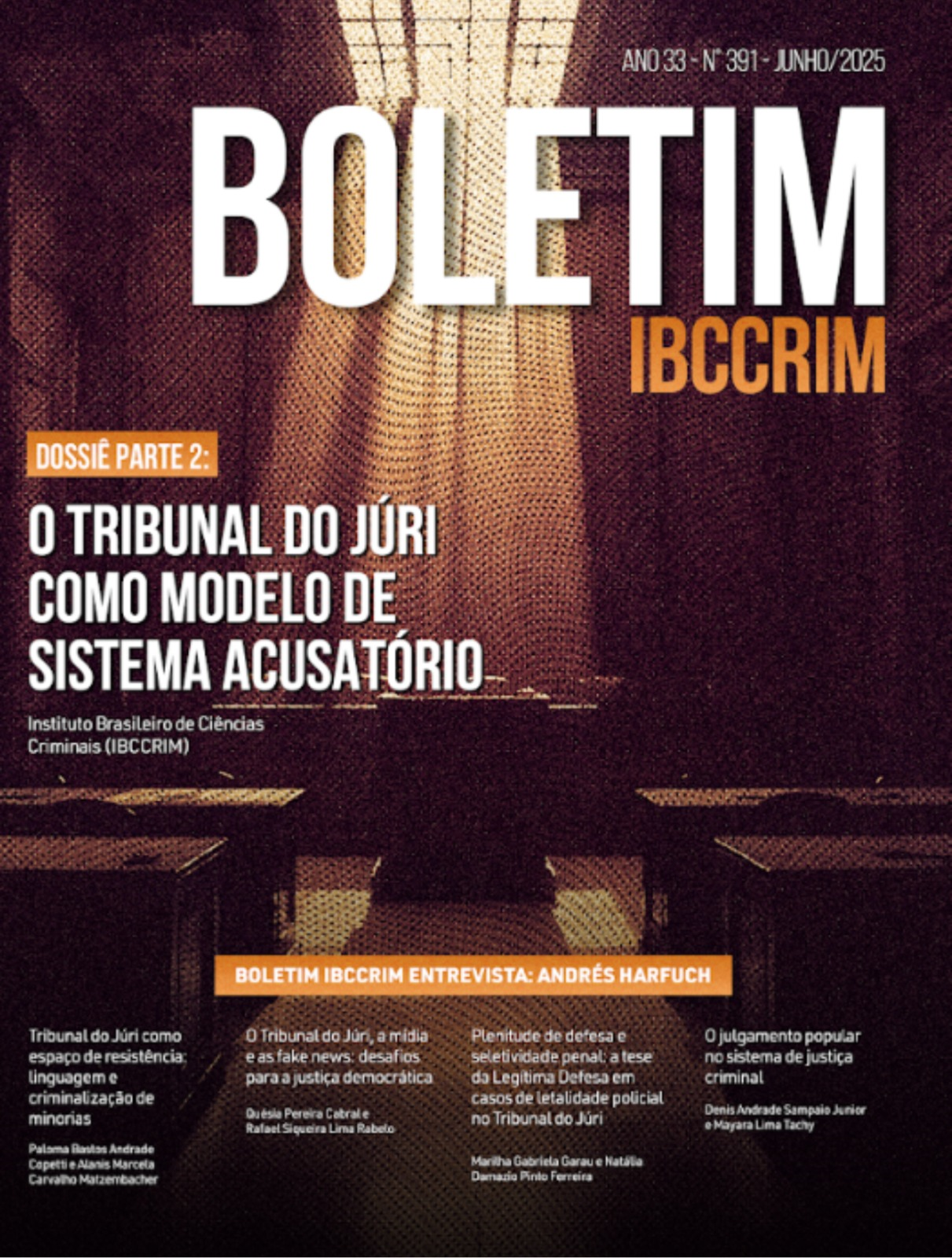The people’s judgment in the criminal justice system
Views: 43DOI:
https://doi.org/10.5281/zenodo.15079373Keywords:
Jury Court, Democratic reserve, Decision, institutional filtersAbstract
The Jury, as a constitutional clause, guarantees popular participation in the formation of criminal decisions. Despite criticisms, especially regarding the influence of prejudices and lack of reasoning in decisions, we defend its democratic relevance. Improvements are suggested, such as the recognition of the decision of indictment as a constitutional filter to ensure fairer and more equitable trials by the Jury Court.
Downloads
Publication Facts
Reviewer profiles N/A
Author statements
- Academic society
- Instituto Brasileiro de Ciências Criminais
- Publisher
- IBCCRIM
References
BARROSO, Anamaria Prates. Por um processo penal não racista: a racialização do processo penal como forma de enfrentamento do racismo nas práticas processuais penais. Belo Horizonte: D’Plácido, 2023.
BINDER, Alberto M. Crítica à justiça profissional. Tradução: Jefferson de Carvalho. In: SAMPAIO, Denis (org.). Manual do Tribunal do Júri: a reserva democrática da justiça brasileira. 2. ed. Florianópolis: Emais, 2023. p. xx-xx.
BRASIL. [Constituição (1988)]. Constituição da República Federativa do Brasil. Brasília: Senado Federal, 1988. Disponível em: https://www.planalto.gov.br/ccivil_03/constituicao/constituicaocompilado.htm. Acesso em: 16 mar. 2025.
DIAS, Paulo Thiago Fernandes. A decisão de pronúncia baseada no in dubio pro societate: um estudo crítico sobre a valoração da prova no processo penal constitucional. 2. ed. Florianópolis: Emais, 2021.
FÓRUM BRASILEIRO DE SEGURANÇA PÚBLICA. Anuário Brasileiro de Segurança Pública 2022. São Paulo: Fórum Brasileiro de Segurança Pública, 2022. Disponível em: https://forumseguranca.org.br/wp-content/uploads/2022/06/anuario-2022.pdf. Acesso em: 22 mar. 2025.
HARTSOE, Steve. Study: all-white jury pools convict black defendants 16 percent more often than whites. DukeToday, 17 abr. 2012. Disponível em: https://today.duke.edu/2012/04/jurystudy. Acesso em: 22 mar. 2025.
SÃO PAULO (Estado). Tribunal de Justiça do Estado de São Paulo. Comarca de Campinas (5ª Vara Criminal). Sentença. Processo Físico nº: 0009887-06.2013.8.26.0114. j. 4 jul. 2016. Disponível em: https://www.conjur.com.br/wp-content/uploads/2023/09/juiza-reu-nao-parece-bandido-branco.pdf. Acesso em: 22 mar. 2025.
SILVA, Rodrigo Faucz Pereira; AVELAR, Daniel Ribeiro Surdi de. O voir dire como ferramenta para a seleção de jurados imparciais. Consultor Jurídico, 3 jul. 2021. Disponível em: https://www.conjur.com.br/2021-jul-03/tribunal-juri-voir-dire-ferramenta-selecao-jurados-imparciais/. Acesso em: 22 mar. 2025.
SOMMERS, Samuel R. On racial diversity and group decision making: identifying multiple effects of racial composition on jury deliberations. Journal of Personality and Social Psychology, v. 90, n. 4, p. 597-612, 2006. https://doi.org/10.1037/0022-3514.90.4.597
TOURINHO FILHO, Fernando da Costa. Manual de Processo Penal. São Paulo: Saraiva, 2013.
VALE, Ionilton Pereira do; SANTOS, Teodoro Silva dos. O Tribunal do Júri no contexto dos direitos humanos: análise da instituição à luz das convenções internacionais de direitos humanos. Rio de Janeiro: Lumen Juris, 2017.
Downloads
Published
How to Cite
Issue
Section
License
Copyright (c) 2025 Dr. Denis Andrade Sampaio Junior

This work is licensed under a Creative Commons Attribution-NonCommercial 4.0 International License.
Copyright of published articles belongs to the author, but with journal rights over the first publication and respecting the one-year exclusivity period. Authors may only use the same results in other publications by clearly indicating this journal as the medium of the original publication. If there is no such indication, it will be considered a situation of self-plagiarism.
Therefore, the reproduction, total or partial, of the articles published here is subject to the express mention of the origin of its publication in this journal, citing the volume and number of this publication. For legal purposes, the source of the original publication must be consigned, in addition to the DOI link for cross-reference (if any).


 Português (Brasil)
Português (Brasil)
 English
English
 Español (España)
Español (España)






